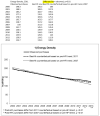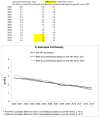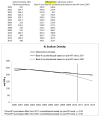Gains Made By Walmart's Healthier Food Initiative Mirror Preexisting Trends
- PMID: 26526244
- PMCID: PMC4692370
- DOI: 10.1377/hlthaff.2015.0072
Gains Made By Walmart's Healthier Food Initiative Mirror Preexisting Trends
Abstract
Healthier food initiatives conducted by national food retailers may offer opportunities to improve the nutritional profile of food purchases. Using a longitudinal data set of packaged food purchases made by US households, we examined the effect of a healthier food initiative officially launched by Walmart in 2011. From 2000 to 2013, household-level purchases of packaged foods at Walmart showed major declines in energy, sodium, and total sugar density, as well as in quantities of sugary beverages, grain-based desserts, snacks, and candy. These trends in packaged food purchases were more pronounced than similar concurrent trends seen at other major food retailers. However, the declines seen at Walmart after the initiative's official implementation did not exceed what would have been expected had pre-implementation trends continued, and therefore they cannot be attributed to the initiative. These results suggest that food retailer-based initiatives that purportedly create a healthier food environment may not suffice to improve the nutritional profile of food purchases. More systemic shifts in consumers' characteristics and preferences may be needed.
Keywords: Health Promotion/Disease Prevention; Public Health; food purchases; sugar sweetened beverages; supercenters.
Project HOPE—The People-to-People Health Foundation, Inc.
Figures




References
-
- Glanz K, Bader MD, Iyer S. Retail grocery store marketing strategies and obesity: an integrative review. Am J Prev Med. 2012;42(5):503–12. - PubMed
-
- Wood S. Revisiting the US food retail consolidation wave: regulation, market power and spatial outcomes. Econ Geog. 2013:lbs047.
Publication types
MeSH terms
Grants and funding
LinkOut - more resources
Full Text Sources
Other Literature Sources
Medical

